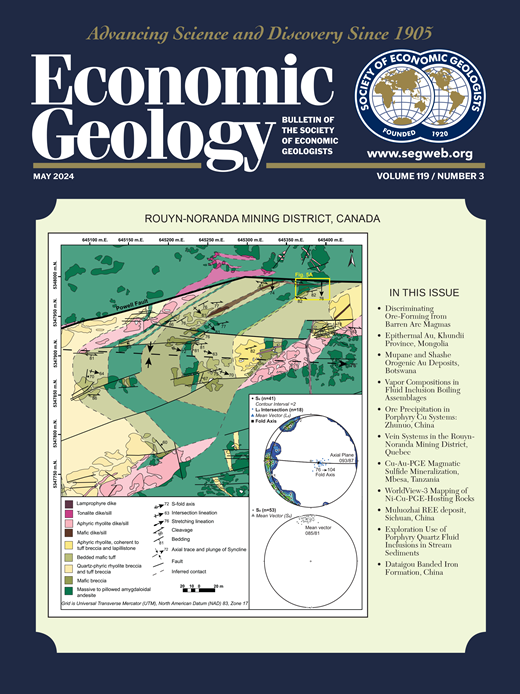利用机器学习解释黄铁矿激光烧蚀-电感耦合等离子体质谱图:以南加州Colosseum金矿为例
IF 4.9
1区 地球科学
Q1 GEOCHEMISTRY & GEOPHYSICS
引用次数: 0
摘要
本研究探讨了机器学习技术在黄铁矿激光烧蚀-电感耦合等离子体质谱(LA-ICP-MS)图谱的增强解释中的应用。位于南加州的Colosseum金矿被认为是一个研究案例。该矿床与流纹岩角砾岩-管杂岩有关,金成矿与早黄铁矿和晚黄铁矿两代主要黄铁矿有关。我们的机器学习工作流程包括通过无监督聚类来检测单个图中的不同成分区域,并在第二个聚类步骤中根据成分相似性对这些区域进行分组,从而实现不同图之间的直接比较,并提供代表矿床中存在的各种矿化风格的黄铁矿的成分概述。单个图的聚类正确区分了不同的早期黄铁矿生长带、横切早期黄铁矿生长的裂缝和晚期黄铁矿生长带,与岩石学观察相吻合。第一步检测到的所有带依次被划分为两个成分不同的组和第三个过渡组,使地图之间能够直接比较,同时保持岩石学的一致性。对于Colosseum,我们的方法显示:(1)金在晚期黄铁矿中比早期黄铁矿更丰富,但在两代和两个Colosseum矿化角砾岩管中都可以发现大量的金;(2)黄铁矿由富co - ni - te端元转变为富cu - ag - zn - sb - tl端元;(3)两代黄铁矿中Au与As直接相关。本文章由计算机程序翻译,如有差异,请以英文原文为准。
The Interpretation of Pyrite Laser Ablation-Inductively Coupled Plasma-Mass Spectrometry Maps Using Machine Learning: A Case Study of the Colosseum Au Deposit, Southern California
This study explores the application of machine learning techniques for an enhanced interpretation of pyrite laser ablation-inductively coupled plasma-mass spectrometry (LA-ICP-MS) maps. The Colosseum Au deposit, in southern California, was considered as a case study. Colosseum is genetically related to a rhyolitic breccia-pipe complex, where Au mineralization is associated with two main pyrite generations—early pyrite and late pyrite. Our machine learning workflow involves the detection of distinct compositional zones in individual maps through unsupervised clustering, and a second clustering step where these zones are grouped by compositional similarity, enabling the direct comparison between different maps and providing a compositional overview of pyrite representative of the various styles of mineralization present in the deposit. Clustering of individual maps correctly differentiated between distinct growth zones in early pyrite, fractures that crosscut early pyrite growth, and zones of late pyrite growth, matching petrographic observation. All the zones detected by this first step, in turn, were classified into two compositionally distinct groups and a third transitional group, enabling the direct comparison between maps while keeping petrographic consistency. For Colosseum, our approach revealed that (1) Au is more abundant in late pyrite than early pyrite, but significant amounts can be found in both generations and in both Colosseum mineralized breccia pipes; (2) the transition from early to late pyrite is represented by a change from a Co-Ni-Te–rich end member to a Cu-Ag-Zn-Sb-Tl–rich end member; and (3) Au is directly correlated with As in both pyrite generations.
求助全文
通过发布文献求助,成功后即可免费获取论文全文。
去求助
来源期刊

Economic Geology
地学-地球化学与地球物理
CiteScore
10.00
自引率
6.90%
发文量
120
审稿时长
6 months
期刊介绍:
The journal, now published semi-quarterly, was first published in 1905 by the Economic Geology Publishing Company (PUBCO), a not-for-profit company established for the purpose of publishing a periodical devoted to economic geology. On the founding of SEG in 1920, a cooperative arrangement between PUBCO and SEG made the journal the official organ of the Society, and PUBCO agreed to carry the Society''s name on the front cover under the heading "Bulletin of the Society of Economic Geologists". PUBCO and SEG continued to operate as cooperating but separate entities until 2001, when the Board of Directors of PUBCO and the Council of SEG, by unanimous consent, approved a formal agreement of merger. The former activities of the PUBCO Board of Directors are now carried out by a Publications Board, a new self-governing unit within SEG.
 求助内容:
求助内容: 应助结果提醒方式:
应助结果提醒方式:


